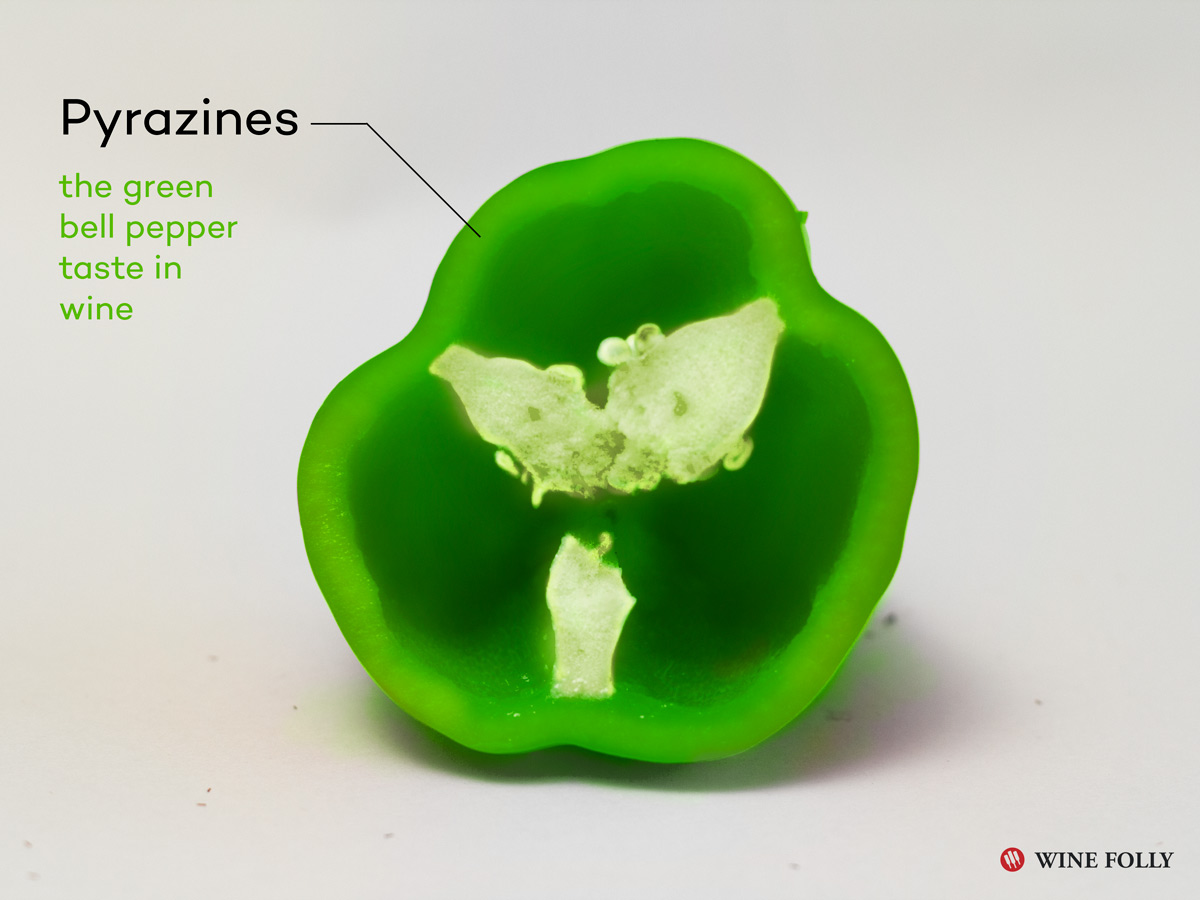Learn which red and white wines are known for having these savory (herbal and vegetal) aromas, why these aromas happen, and how to seek out high quality wines.

Why Some Wines Taste like Bell Pepper
If you’ve been wondering why youthful wines from particular grapes taste really fruit-driven and others have a wide array of savory flavors, the answer may be methoxypyrazine. A group of these savory flavors (which includes “bell pepper”) come from a from a specific aroma compound called methoxypyrazine (often called “pyrazines” for short). The compound is found in higher proportions in the “Bordeaux-family” grapes:
- Sauvignon Blanc
- Cabernet Franc
- Cabernet Sauvignon
- Merlot
- Carménère
- Malbec

The varieties that contain higher levels of pyrazines all originate around Bordeaux and are genetically related. For example, did you know that Cabernet Franc is the parent grape of Merlot, Cabernet Sauvignon and Carménère?
“By controlling the leafy part of the vines, growers can tweak what sort of aromas the vines generate in their grapes.”
Here’s where it starts to get interesting, these wines don’t always smell green. For many years, winemakers and viticulturists (grape growers) scratched their heads trying to discover why, until scientific research revealed a few mechanisms that generate the green smells in these specific grapes. Researchers found the presence of methoxypyrazine can be reduced or altered with more attentive vineyard management. By controlling the leafy part of the vines, growers can tweak what sort of aromas the vines generate in their grapes. In other words, pruning has a big role in how these wines develop flavors.
Pyrazines: not necessarily a negative
On the bad side, pyrazine can smell like old asparagus water or mushy, steamed green pepper. But on the good side, pyrazines can yield charming, complex flavors that add the signature identity to these grapes. For example, Sauvignon Blanc when done right offers a fresh herbaceous quality of chocolate mint, tarragon, fresh parsley or sweet basil. If you’re looking for Sauvignon Blanc in this style, the great producers of the eastern Loire Valley (e.g. Sancerre, Pouilly Fumé) are masters of this style.
For Cabernet Sauvignon and the other red Bordeaux varieties, have positive attributes associated with pyrazine such as fire-roasted red pepper paste, green peppercorn, green olive tapenade, and mint. Moreover, different red Bordeaux varieties have inherently higher and lower concentrations of pyrazines. Carménère and Cabernet Franc have the highest, followed by Merlot and Cabernet Sauvignon, and Malbec has the lowest. The levels vary based on climate and cooler regions (and vintages) will always have higher levels of pyrazine.
Don’t like pyrazines? How to find less “green” tasting wines:
Many wine drinkers dislike green aromas, particularly in red wines. Here are a few tactics to avoid them:
- Be sure to read tasting notes and look for clues like “bell pepper,” “green peppercorn,” or “herbal notes” that may indicate the wine has detectable levels of methoxypyrazine.
- Look for wines rated 89 points or higher (for the specific varieties listed above) from Robert Parker. Robert Parker and his reviewers have tuned their sensitivities to pay attention specifically to methoxypyrazine. RP ratings tend to rate wines with more ripeness and less “green” notes higher. We’ve also noted that James Suckling appears to rate wine with the ripeness method as well. Neither of them would appear to be the biggest fans of pyrazine, in any form.
- Seek out hotter vintages when buying wines from cooler climate regions. The regions of Bordeaux, Chile, the Loire Valley, New Zealand, Northern Italy (Veneto and Friuli), and New York State can produce wines with higher vegetal aromas when there’s more inclement weather. You can use the vintage charts at Berry Bros. and Rudd or Robert Parker for vintage quality information.
- Or… You could just avoid Bordeaux-family grapes altogether!
Pyrazines do age well…

The 1999 vintage had higher pyrazines, but with 15 years, the aromas were well-integrated into the overall complexity of the wine . from How Wines Age
If you love herbal savory flavors in wine, you should know that the presence of pyrazines in wine aren’t necessarily a fault, they can contribute to the complexity of a great wine. In fact, the bitter, herbal flavors that are disliked in the first few years often change, integrating with the overall aromatic profile of the wine. We found this to be true in a taste comparison of Merlot over a period of 30 years: the less-ripe vintages ended up tasting the best in the long term.
